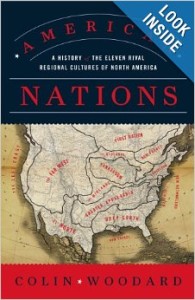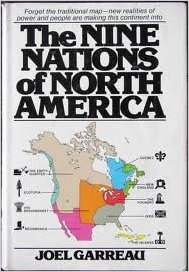
Note: Graphic does not properly show First Nation, including Greenland and larger than the USA, with roughly 300,000 inhabitants and in pole position (pun intented) to be the future core for humanity.
Tip of the Hat to SchwartzReport
UPDATED 19 FEB 14:
Review: American Nations – A History of the Eleven Rival Regional Cultures of North America
See Also:
2013 Healing the Americas with an Open Source Agency
Graphic: Robert Steele Global Strategy – The Hourglass Home Base Plus Four
SchwartzReport: South America Rising + New World Order II Meta-RECAP
Summary and RECAP Below the Line.

Woodard lays out his map in the new book American Nations: A History of the Eleven Rival Regional Cultures of North America. Here’s how he breaks down the continent:
Yankeedom: Founded by Puritans, residents in Northeastern states and the industrial Midwest tend to be more comfortable with government regulation. They value education and the common good more than other regions.
New Netherland: The Netherlands was the most sophisticated society in the Western world when New York was founded, Woodard writes, so it’s no wonder that the region has been a hub of global commerce. It’s also the region most accepting of historically persecuted populations.
The Midlands: Stretching from Quaker territory west through Iowa and into more populated areas of the Midwest, the Midlands are “pluralistic and organized around the middle class.” Government intrusion is unwelcome, and ethnic and ideological purity isn’t a priority.
Tidewater: The coastal regions in the English colonies of Virginia, North Carolina, Maryland and Delaware tend to respect authority and value tradition. Once the most powerful American nation, it began to decline during Westward expansion.
Greater Appalachia: Extending from West Virginia through the Great Smoky Mountains and into Northwest Texas, the descendants of Irish, English and Scottish settlers value individual liberty. Residents are “intensely suspicious of lowland aristocrats and Yankee social engineers.”

Deep South: Dixie still traces its roots to the caste system established by masters who tried to duplicate West Indies-style slave society, Woodard writes. The Old South values states’ rights and local control and fights the expansion of federal powers.
El Norte: Southwest Texas and the border region is the oldest, and most linguistically different, nation in the Americas. Hard work and self-sufficiency are prized values.
The Left Coast: A hybrid, Woodard says, of Appalachian independence and Yankee utopianism loosely defined by the Pacific Ocean on one side and coastal mountain ranges like the Cascades and the Sierra Nevadas on the other. The independence and innovation required of early explorers continues to manifest in places like Silicon Valley and the tech companies around Seattle.
The Far West: The Great Plains and the Mountain West were built by industry, made necessary by harsh, sometimes inhospitable climates. Far Westerners are intensely libertarian and deeply distrustful of big institutions, whether they are railroads and monopolies or the federal government.
New France: Former French colonies in and around New Orleans and Quebec tend toward consensus and egalitarian, “among the most liberal on the continent, with unusually tolerant attitudes toward gays and people of all races and a ready acceptance of government involvement in the economy,” Woodard writes.
First Nation: The few First Nation peoples left — Native Americans who never gave up their land to white settlers — are mainly in the harshly Arctic north of Canada and Alaska. They have sovereignty over their lands, but their population is only around 300,000.
Phi Beta Iota: Others have done this work before, and their works are listed below. A complementary but less well executed book, Our Patchwork Nation: The Surprising Truth About the “Real” America, lists the following “types” of community that we find less compelling — they could however be overlain with the more deeply rooted eleven nations above, all to the end of demonstrating that America has fragmented beyond repair (absent a compelling precipitant of revolution and a charismatic leader able to bridge all divides with a simple message that is credible.
Boom Towns
Campus and Careers
Emptying Nests
Evangelical Epicenters
Immigration Nation
Industrial Metropolis
Military Bastions
Minority Central
Monied ‘Burbs
Mormon Outposts
Service Worker Centers
Tractor Country
See Also:
Review (Guest): American Nations – A History of the Eleven Rival Regional Cultures of North America
Review: An Atlas of Poverty in America–One Nation, Pulling Apart, 1960-2003
Review: The Clustered World –How We Live, What We Buy, and What It All Means About Who We Are
Review: The Edge of Disaster–Rebuilding a Resilient Nation
Review: The Nine Nations of North America
Review: TYRANNICIDE The Story of the Second American Revolution
Review: Where Have All the Leaders Gone?
Review: Who Stole the American Dream?
Worth a Look: Book Reviews on Democracy Lost & Found
Worth a Look: Book Reviews on Self-Determination & Secession



